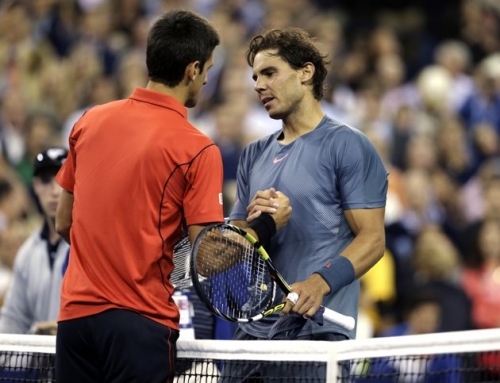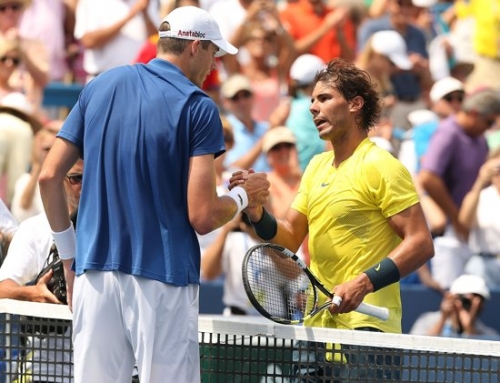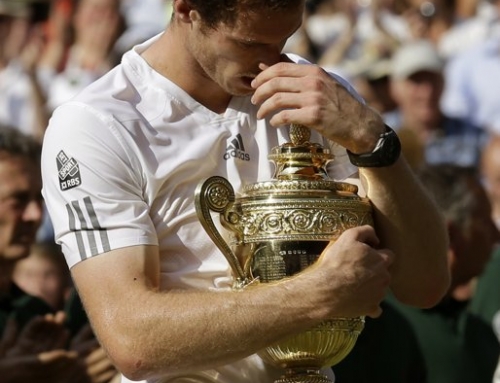Wimbledon is a good time to take the temperature of tennis. It’s about halfway through the tennis season, but because tennis is played mostly in the northern hemisphere and played mostly outdoors, it must usually be played in summertime or certainly late spring lest we subject our pros to cold and we prefer to subject them to heat. The consequence of this is that by July, three Slams have been played with only one more after July, namely, the US Open.
The conclusion of Wimbledon usually means a time of rest for the very top pros who have played an intense schedule of tennis which basically starts at Indian Wells and doesn’t stop until a Wimbledon crown has been awarded to the last man standing.
The top pros, having slogged for so long, often take a month off splitting the time between rest and recovery and training for the last Slam of the season.
Where were we at the conclusion on Wimbledon?
When the French Open semis were set, we had something very unusual: the top four seeds were in the semifinals. While three of the four players were not unexpected, after all, Rafa is the king of clay, and despite Roger’s fast court prowess, he’s often gone deep at the French, and Djokovic seems as comfortable on clay as hard courts, it was the Scot, Andy Murray, whose passive style often sets him up for heartache at Roland Garros. And this year seemed no different than any other year, especially when Andy Murray twisted an ankle against Michael Berrer who had, up to that point, been doing OK for himself, not great, but moving the Scot around. Once the ankle twisted, something unusual happened.
Berrer felt compassion. He didn’t want to beat Andy Murray by drop shotting him. So he competed as he normally would–from the baseline, and Andy Murray, being hobbled, had no choice but to go after one big shot after another, and won the match as easily as if he were healthy. Murray managed to get past Viktor Troicki when he felt a bit of pressure trying to close the fifth set, then faced a steady, but not spectacular player in Chela, and reached his first semis ever.
The top four seeds almost made it to the semis again at Wimbledon, except Roger Federer found a man he could hardly break, extending a dilemma he’s had the last few Wimbledons. Federer broke Tsonga the only one time he had a chance, and couldn’t sustain a return game to create a break opportunity in four more sets. Meanwhile, Murray won a set against Nadal, but then his aggressive play began to fall apart, and the errors piled on, and Nadal punched his ticket to the final where he would play Novak Djokovic, his newfound nemesis. Four consecutive defeats by the wily Serb had left an indelible mark on the Spaniard’s psyche who, despite a solid third set win, found that a resurgent Djokovic was too much to handle. So Djokovic not only took the Wimbledon crown, but also the number one ranking.
And then everyone went away for a few weeks. Djokovic, Federer, Nadal, Murray.
After a month passed, everyone wondered whether the top four were eager for competition, ready to continue from where they left off, and the answer so far is mostly no.
Rafael Nadal did pretty well to push Ivan Dodig to two tiebreaks, but it is a bit peculiar for the former number one to break three times for the lead and yet give up the serve each time. Nadal tends to play poorly before the US Open, and so this loss, despite the earliest he’s had in quite some time, can be overlooked.
Last year, Nadal lost to Murray in the semifinals of Toronto. In Cincy, he lost to Marcos Baghdatis. Nadal had looked pretty rusty, but as usual, he was coming off injury. He had also been tinkering with his serve. All of a sudden, he seemed to be getting about 10 mph on his serve. His game was a bit erratic leading to the US Open, but that would often happen when Uncle Toni stayed at home.
Nadal obviously recovered just fine during the US Open. His serve really made it that much tougher to break him, and he used it to win the US Open for the first time.
Before 2010, Nadal struggled with injuries. Nadal often played well up to Wimbledon, but by the time the US Open was rolling around his body was wearing down. 2008 should have been a breakthrough year, but Murray played magnificent tennis to reach his first finals. 2009 revealed an abdominal injury that Nadal tried to keep secret, and partly contributed to a del Potro beatdown.
These days, Nadal seems to time his preparation for the US Open better. In the past, he would get injured and miss part of the season after the US Open. These days, he seems to be able to play until the end of the year.
Because of all the surprise early losses at Montreal, including Rafael Nadal, it’s really hard to tell what Nadal’s form is. We’ll need to see what Cincy holds in store. Nadal should fare a bit better mostly because he faces a Spaniard. Guillermo Garcia-Lopez has beaten Nadal before, last year in Bangkok. However, it would be surprising for Nadal to go out in his opening round again. Nadal will want a few matches to get back into shape before the US Open since he doesn’t usually play that well without a half-decent tournament.
If Nadal looked a bit out of sorts, then Andy Murray looked very rusty. If Nadal’s loss was surprising, at least he had many chances to win. Murray, on the other hand, looked awful and it got worse. Murray has talked about peaking at the US Open. Last year, he felt he was a bit tired going into the US Open. 2010 was his second straight year with problems at the US Open. In 2010, he lost to Stan Wawrinka, a player he’s trained with before and who had given him trouble at Wimbledon. In 2009, Murray lost rather tamely to Marin Cilic, though to be fair, people began talking about Cilic maybe becoming a top 5 player.
To be fair, Andy Murray, who has always targeted the US Open as the one tournament he most wants to win, has never fared particularly well except in this breakout year in 2008. In 2007, before he made a serious move up, Andy Murray lost in the third round to Hyung-Taik Lee. The year before, he lost in the fourth round to Nikolay Davydenko. The year before, he lost in the second round to Arnaud Clement. What did all those matches have in common? Murray won a five setter in the previous round. In the times before 2008, Murray had not been working on his fitness, so he often struggled after a long match and struggled in long matches, losing energy before the match was over.
These days, the fitness part is no longer a problem. What is a problem is Murray’s motivation which is more volatile than any of the other top 4 players, at least, ever since Djokovic resolved his own personal demons. Maybe that would matter less if Murray didn’t play a flat passive style that resembles Monfils more than any other player, relying on speed to win him points. We all know Murray is capable of hitting harder, and he does it at times. Last year, for example, he beat a resurgent David Nalbandian (who has since gone back to playing the kind of tennis that caused him to drop out of the top ten), Rafael Nadal and Roger Federer.
He pretty much won all three matches the same way: playing aggressive tennis. However, by the time Murray reached Cincy last year, he was starting to fade. He lost to Mardy Fish for the third time in 2010. Despite losing relatively early, Murray did not do that well in the US Open, losing to Stan Wawrinka in the third round.
Murray’s best playing usually comes at either Wimbledon or the Australian Open. One reason Murray seems to fare better at Wimbledon is that most players don’t handle the bounce of the grass well. Whatever Murray’s weaknesses are, he seems to understand grass. The Australian Open may be more indicative of Murray’s play. Twice, he has reached the finals. However, to gear up for the event, Murray played Hopman Cup. In Hopman Cup, he’s guaranteed three singles matches, typically against players ranked lower than 10, and he plays three mixed doubles. It’s an exhibition, so it doesn’t hurt even if he loses, and it’s in Perth where it’s suitably warm, unlike Doha, which, while hot in the daytime, is cool in the evenings when matches are scheduled.
Much has been made of Djokovic’s gluten-free diet, which is the explanation the tennis media has given to Djokovic’s resurgence. The diet may not have improved his forehand, but he does seem to avoid fatigue when playing in heat. Djokovic had been more susceptible to heat than others causing him to retire from many matches, so much so that people were beginning to joke that he would have a Grand Slam of retirements.
Let’s move to Federer. The US Open has been one of Federer’s better tournaments. He’s lost early at the French and at Wimbledon, but the US Open has been pretty good to Federer. Last year was the first year that Federer had not reached the finals since 2003, and he still reached the semifinals. The last two years, Federer won Cincinnati. Especially critical was his performance in 2009 where he beat both Djokovic and Murray to win the title. Last year, Federer had a nicer draw. Murray lost early, as did Nadal and Djokovic. Federer really wanted to defend this title because it would give him a 2 seed. He wasn’t in much danger, but Djokovic had closed the gap enough that he could have overtaken Federer if he had played well and Fed had played poorly.
With Federer losing to Tsonga, it’s unclear where Federer’s game is now. It seems like he’s playing reasonably well, but obviously not as good as his best years and seemingly not as good as the end of last year. Federer is likely to play Juan Martin del Potro in the second round. del Potro has still not returned to his thunderous form that lead him to the 2009 US Open title, but his steady play could still pose problems for Federer. It should be a match that Federer wins, but it certainly be a match to watch. Of course, even if Federer loses, he’ll say that it isn’t the US Open and so there’s nothing to worry about.
Expect Roger to start playing more patient tennis, lengthening out the points, and not being as impatient as he was in Montreal. Roger seems to conserve energy these days, and he does this by being more aggressive than usual in non-Slam events. I believe Roger tries to play aggressive for another reason. He doesn’t want to start getting passive because he’s not a very good passive player. Roger’s main strategy these days is to be mentally tough on his serve games, which is tough because Roger doesn’t have a pure pace serve. He hits his spots. When he does it well, he wins serves easily. But usually a few games a match, especially against better competition, he will struggle.
He should be working on his return of serve and getting more into play, but Roger has never had great stats as a returner. Nadal, Djokovic, and Murray all have something in common. They all return very well. Federer tends to slice his returns back or play too aggressive and miss returns. In particular, Federer rarely likes to stand really far back on returns which does lead him to struggle at times and play matches whose scores are closer than one might expect. Federer doesn’t care, of course. He just cares how often he is broken. He is following the Sampras model of holding serve and looking for one good break. The difference is Sampras could ace his way out of problems and Federer often has to play long points to get himself out of a mess.
With Federer, Murray, and Nadal having fallen early, it’s hard to say how any of them are playing. Murray has to play a lot better, but he’s shown he can do this. Nadal appears to still have some nerves, and more than any other player, seems to really work hard at his weaknesses. I think he wants to be more aggressive on return games. He showed glimpses of this against Dodig, but it wasn’t always successful. Where Nadal struggled was on his serve, which totally went south, but that’s the part of his game he seems to be able to get on track, especially since he tends to play it safer than the other players.
That leaves us with Djokovic. Heading into Montreal, experts said he had a tough draw. He would face Davydenko, but not the Davydenko of 2009. He would face either del Potro or Cilic, but not the 2009 version. He did play a relatively in-form Monfils and Tsonga, and had his best match against Monfils. His first two matches were shaky. Davydenko played very high-risk tennis which made it tough for Djokovic to get a rhythm, but all he had to do was keep the ball in play. He struggled a bit against Cilic, but again, his superior form eventually got through.
So by the end of the tournament. Djokovic was the only top seed remaining. Clearly, if he wins over Fish, as he’s expected to, Djokovic will reaffirm, once again, that he’s the number one player, and he’ll have done something that no one since Sampras has done: won the first tournament as number one.
If he loses, then it will probably just be a blip, presuming he doesn’t get injured, that is.
So, in a nutshell, we don’t know how Nadal, Murray, and Federer are playing yet, and Djokovic is still playing like number 1.




![[US Open Men’s Final] Can Djokovic beat Nadal in the finals?](https://www.essentialtennis.com/wp-content/uploads/2013/09/20130909djokovic-500x383.jpg)


![[French Open] The tactics of the Djokovic-Nadal semifinals](https://www.essentialtennis.com/wp-content/uploads/2013/06/20130607nole-500x383.jpg)